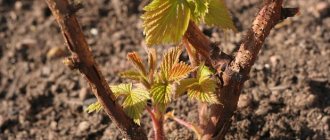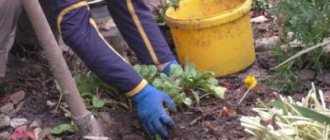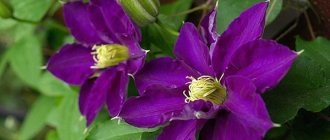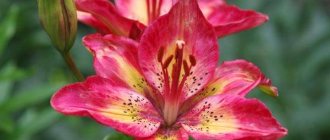Indoor plants are usually replanted in February-March or when they begin to actively grow. Replanting is not prohibited at other times of the year, but the risks and consequences of changing containers and substrate are not the same. One of the most difficult periods for replanting indoor pets is autumn. Changes in lighting and temperatures already affect the condition of plants, so autumn replanting is the most dangerous. But you can replant plants in the fall. True, this should be done only when there is truly an urgent need.
Is it possible to replant indoor plants in the fall?
Groups of perennial flowers
Perennial flowers are divided into two groups. Firstly, these are heat-loving crops that cannot overwinter in our climate. They have to be dug up annually in the fall, stored at positive temperatures and in special conditions, and planted in the spring. This group includes many tuberous and bulbous flowers. For example, the flowers of gladiators and warriors are gladioli, or cheerful dahlias.
The second group consists of rhizomatous frost-resistant flowers that overwinter directly in flower beds and flower beds. These perennial flowers do not need to be replanted annually, because many of them can grow in one place from 4 to 10-12 years. But these flowers will also require replanting and dividing the bush after some time.
Why is it necessary to divide perennial flower bushes?
Because over the years of vegetation, the root system of the plant grows wider and upward. Roots and rhizomes interfere with each other and compete for food. Old, dying roots interfere with young developing ones. The roots come to the surface, which can cause them to freeze. To allow the young parts of the plant to develop, perennials are transplanted and divided.
Indications for transplantation
- The earthen ball dries out very quickly. This is a signal that the root system has grown, and the volume of water that fits in the pot is not enough for it.
- The plant looks sick and withers, although the soil is moistened. A possible reason for this is overwatering and the appearance of root rot. The control measure is replanting and healing the roots.
- The flower is healthy in appearance, but grows poorly. The soil has become compacted and does not allow oxygen to pass through well. The soil needs to be replaced.
- The crown of your indoor pet has grown, it has become unstable - change the container to a larger one.
When to divide perennials
You can determine that plants need replanting by looking at the “bald” center of the bush. If flowering has become scarce and the flowers have become smaller. As a rule, dividing perennials is carried out every five to six years. Experienced gardeners annually rejuvenate, divide or replant two or three perennials in the flowerbed. Thus, the overall decorative effect of the flower garden is not disturbed.
Dividing the bush and replanting perennials is carried out in early spring, before foliage grows, and in the fall, a month and a half before a steady cold snap. Perennial flowers that bloom in late summer and fall are replanted in the spring. So that before flowering they have time to take root, recover and bloom in due time.
In the fall, perennials that have bloomed in the spring and early summer are replanted. Before the cold weather, they must take root in a new place and get stronger, preparing for winter.
Perennial flowers that are replanted in early autumn
In September, the unpretentious astilbe, this beauty of the shady garden, is replanted. However, this plant easily tolerates transplantation at any phase of the growing season. Brunnera, herbaceous peony, delphiniums and lupins are planted and divided in early autumn. Transplanted hostas, irises, clematis, and phlox take root well at this time.
As a rule, new varieties of these plant species can be planted at the same time.
When is autumn replanting necessary?
In the fall, the same rules apply for indoor plants as at any other time, but only a serious reason can serve as a reason to change the soil and container.
1. Extreme soil depletion or critical loss of its key characteristics . If the soil has become too compacted, turned into an impenetrable block, and does not allow water and air to pass through, the plant has not been replanted for so long that the soil has exhausted all its resources. In all cases when external signs of depletion or unsuitability of the soil for further plant growth appear, an emergency replanting is needed.
2. Critical outgrowing of pot volumes . In the fall, plants that physically have nowhere to develop are necessarily replanted. If in the summer the plant grew rapidly, the rhizome has grown so much that it has entwined the entire earthen ball, and the roots not only appear, but crawl out of the drainage containers and/or the top of the substrate, the earthen ball is so filled with roots that even water does not penetrate into it - replant immediately!
3. Souring, molding and salting of the soil . The easiest way to identify this problem is by the appearance of the soil (salt crystals accumulate on the surface and walls of containers) and smell, because the affected soil emits a specific sour or mushroom aroma. But the first sign is a sickly, withering plant. Salting causes incorrect water composition and watering with unsettled water. But souring and the spread of mold are caused only by improper, excessive watering and stagnation of water - in pots and trays, including as a result of the lack or incorrect selection of drainage and depth of containers.
4. Incorrect selection of soil according to acidity . If for plants growing only in slightly acidic and acidic substrates, soil with an alkaline reaction was used (and vice versa), as a rule, by the fall the consequences of a mistake in soil selection will become obvious and inevitable.
5. Infection of the soil by pests, including nematodes, or severe damage to plants by fungal diseases, the pathogens of which could remain in the substrate . When affected by any pests living in the soil, especially if we are talking about plants of the group of tuber-bulbous species, waiting for fungicides to help cope with the problem is most often useless. It is impossible to do without replanting with a complete replacement of soil and thorough disinfection of the roots. It will be necessary to change the substrate with all possible preventive measures for plants that have a risk of re-infection due to damage not only to the above-ground parts, but also to the soil by viruses and diseases. Such a transplant is carried out only after the plant has been cured of the disease, before being transferred from quarantine.
6. Buying a plant in a substrate in poor condition. This includes purchasing tubs that are transported in clean inert soil, purchasing plants at spontaneous markets that grow in dense garden soil, or ordering imported plants that require replacement of the substrate as directed by the supplier. Such a transplant should be postponed until the end of the quarantine period. If the plant simply grew in peat or growth in inert soil can be compensated for by fertilizing, it is always better to postpone the procedure until spring and the optimal timing.
If the root ball is very dense, the roots of the houseplant need to be untangled when replanting in the fall. ©reddit
Perennial flowers: rules for dividing a bush
It is better to start dividing and replanting the bush on a cloudy day. The day before transplanting, the plant should be watered abundantly. So that the leaves and roots have good turgor and can withstand stress more easily.
Also, a day before transplanting, prepare planting holes, filling them with phosphorus-potassium fertilizers or autumn complex fertilizer. You can add wood slag. Nitrogen fertilizers should not be applied in the fall. Because they can provoke the growth of new shoots. Which will not have time to ripen before the cold weather and will die, thereby weakening the bush.
The transplanted bush is dug up widely, trying not to damage the root system. Carefully remove from the soil. Shake off the ground. Carefully inspect the roots and remove dead, diseased and rotten ones with a sharp knife.
Then the locations of the incisions are determined into divisions so that each one has at least three healthy kidneys. Divide the bush with a shovel, knife or pruning shears.
The cuttings are treated with a fungicide solution, for example, “Maxim” or a pink solution of potassium permanganate. Then it would be a good idea to powder the roots and cuts with ash.
The planted sections are watered abundantly, the soil under them is mulched with mowed lawn grass, high-quality compost, and chopped straw. Plantings are covered with spunbond from hot sun rays.
The technology for planting new plants is exactly the same. It’s just important not to miss the optimal planting dates. Because plants planted at a later date will not have time to adapt and take root. As a result, they will die in winter or emerge from wintering extremely weakened. And you shouldn’t expect full flowering in the new season.
Severe soil depletion
A critical decrease in the level of nutrients in the soil can cause the death of flowers. When growing flowers on a windowsill, you need to take into account that their root system is severely limited by the volume of the container; it cannot grow to obtain the necessary minerals.
The soil in pots where fast-growing species were planted, capable of rapidly increasing green mass, is depleted especially quickly. Also, the soil is deprived of nutrients if fertilizing is not carried out. In this case, it is urgent to transplant the plant into a larger container filled with fresh substrate.
Perennial flowers: features of transplanting individual crops
Perennial flowers are very diverse and each crop has its own characteristics.
Peonies
We already talked about how to replant peonies in the article Peonies in August: cut, divide, replant. These luxurious flowers can grow in one place for up to twenty years. But in order for the flowering to be abundant and the flowers themselves not to become smaller, they are replanted every 5-6 years. And this needs to be done at the end of August - very beginning of September. So that the peonies have time to get used to their new place and prepare for the winter.
The peculiarity of planting peonies is that they cannot be buried. If the top bud is more than 1.5 centimeters in the ground, then you will get a bush with abundant luxurious foliage. But you won't get flowers. If the top bud is left above the soil level, it may freeze.
Irises
Growing irises was discussed in the article Irises in the garden: caring for them correctly. Irises require replanting at least once every three to four years. Otherwise, they grow and form a “bald” center of the bush. Lateral roots go deep into the soil and flower buds do not form on them.
Astilbe
This plant is best replanted after flowering. It tolerates transplantation well and easily adapts to a new location. It is only important that there is at least a month left before frost from replanting. By the way, if there is high soil moisture in the shady corners of your garden, feel free to plant astilbe there. It is capable of draining stagnant areas.
Phloxes
Foam caps of these simple flowers can decorate any garden. More information about growing phlox is described in the article at the link.
Phlox are replanted in the second half of September. They tolerate dividing the bush quite easily and take root well in a new place. Phlox bushes should be replanted and divided at least every five years. In addition, phloxes need to be earthed up every fall.
Khosta
We have already talked in detail about the features of growing hosta in the article Hosta - emerald greens and sun glare...
This queen of the shadow does not tolerate transplanting and dividing the bush very well. But in one place it can grow and increase its decorative value for up to two to three decades. That is why the choice of landing site should initially be approached with all seriousness.
The hosta is transplanted no later than the first half of September so that it has time to grow new roots.
In addition to the listed perennials, daylilies are replanted in the fall; they are also called the flowers of the intellectual lazy person, dicentra, or broken heart, adonis. If the bushes are divided and replanted in a timely and correct manner, the perennial flowers will survive the winter well and will delight you with a luxurious appearance in the new season.
Autumn replanting of indoor plants is always an emergency
Almost always, replanting indoor plants in the fall is desirable only in one case - if they need an emergency change of substrate or container. In the fall, replanting and transshipment of indoor plants is carried out only when the condition of the plant, its growth rate, or damage by pests and diseases literally force one to resort to this measure. The exception is bulbous and tuberous plants that are being forced or waking up from a period of dormancy and require replanting before transferring the crop to a warm environment.
Emergency replanting, regardless of the time of year, is always a lot of stress and the last measure that should be taken if there are problems with plants. Before you decide to replant indoor plants in the fall, you should first assess their condition and try any other available measures.
But there is no need to be afraid of autumn transplantation. If there is a need for this, it is better to carry out this procedure quickly, because the affected or weakened plant may not survive winter.
What flowers can and should be planted in the fall at the dacha
Not all flowers are suitable for spring planting. Some only sow in the fall. These include perennials that need cold for good development. Not all flower growers know what flowers can and should be planted in the fall in the country. Such plants adapt more easily to garden conditions. They become stronger and healthier. If you sow flowers in the autumn, they will hurt less. Perennial plants are less often affected by various pests. Therefore, it is worth telling about them in more detail.
Delphiniums must be planted with pieces of rhizomes in early October. The illustration for the article is used under the standard license ©delniesoveti.ru
What flowers can be planted in the fall: 45 names of flowers to plant in the fall.
The second half of summer and autumn are a great time to plant flowers for autumn. We, at Dom-v-sadu.ru
We love all the work related to flowers, so we made a selection of which flowers can be planted in the fall. It will be useful for both experienced and novice flower growers. Many gardeners are afraid to plant plants before winter, but this is completely in vain. So, why is it better to plant flowers in the fall?
Planting bulbous plants in autumn
It makes sense to plant flowers grown from bulbs in the fall. It is important to choose your planting time carefully. If planted too early, when the weather is still warm for a month or more, the flowers will begin to sprout and die from the first frost. If planted too late, the bulbs will not have time to take root well, which will also lead to death from sharp frosts.
Of the bulbous plants that winter most successfully:
- tulip;
- hyacinth;
- crocus;
- narcissus;
- lily;
- Colchicum;
- Pushkinia;
- Chionodox;
- Muscari.
Bulbous flowers intended for winter planting are placed in the soil so that the layer of soil above the bulbs is 2.5-3.5 times thicker than the bulbs themselves.
Crocuses
Crocus or saffron is a bulbous plant that blooms fabulously brightly. Richly colored flowers appear in March-May. Sunny areas (diffused shade is acceptable) and the loosest, most permeable soils are suitable for planting. Spring-blooming crocuses are planted in September or October, choosing bulbs that have not sprouted, are dense and do not have any damage. The latter are able to withstand frosts down to -17-19 degrees, but the larger the planting material, the deeper it is buried.
Hyacinths
Hyacinth is an early spring flower that loves bright sun and flower beds that are never touched by cold winds. Planting is carried out in the first ten days of October, in not too wet soil, since the bulbs can easily rot. If the autumn turns out to be very warm, planting is postponed until early November, since if it is too early, the plant will “grow” and die when cold weather sets in. But it also makes no sense to plant in frozen soil - the flower will not have time to take root.
Tulips
The tulip is rightfully considered the king of spring flower beds. This is a bulbous flower, of which there are hundreds of species, varieties, and thousands of color options. Planting takes place in mid-September - early October, when the air temperature is no higher than +6-11 degrees. The tulip blooms in mid-April - early June, prefers loose, well-drained soil, sunny places where there is no wind and stagnant moisture. The distance from bulb to bulb is approximately 10 cm, between rows - 20-25 cm. Several varieties that bloom at different times are often placed in one flowerbed at the same time.
Daffodils
Daffodils love the sun, but are afraid of cold winds; in the middle zone they bloom in April or May. These perennials have more than two thousand varieties, some of which can grow in partial shade, but bloom most beautifully in the sun. Bulbs are planted in open ground in September. Daffodils are very moisture-loving; loamy soil is optimal for them. The recommended distance between individual bulbs is about 15 cm.
Daffodils are planted only in autumn; spring plantings are not allowed.
Lilies
Lilies look luxurious, very elegant, and have different colors. They bloom in June-August; it is better to grow them in sunny places, in loose, fertile, well-drained soil. Planting, replanting, and dividing bushes is carried out in mid-September - early November, at an air temperature of no more than +10 degrees. The bulbs need to be planted in holes with coarse wet sand, at a distance of at least 15 cm from each other. For the winter, the flower is covered with oak foliage so that it does not rot.
In the fall, only fresh bulbs that are grown and dug up are replanted. It makes sense to plant store-bought material only in the spring.
Colchicum
Colchicum, growing in the middle zone, is unpretentious and has a huge variety of varieties. Up to 20 species are grown in the gardens, blooming in spring or autumn. The flower is poisonous when eaten by pests and can cause harm to pets and humans. Autumn varieties, the dormant period of which falls in the summer, are planted in the first ten days of September, less often - at the very end of August. Small bulbs are embedded in the ground no deeper than 7-8 cm, the largest ones - 10-12 cm.
Iridodictiums or iris
Iris reticulum or iridodictium is a bulbous perennial. It is planted at the very end of September, but not earlier, so that the flower “takes hold”, has time to adapt a little, but does not germinate. Flowering begins a couple of weeks after the snow has completely melted and ends by June. The flowers reach a size of five to eight cm in diameter, they are very fragrant, colored yellow with specks, pale blue, reddish-violet, lilac. The bulbs are covered with a kind of mesh and actively divide during the growth process, producing many “babies”.
Muscari
Muscari, “viper onion”, “mouse hyacinth” are different names for the same flower, painted in blue tones. The plant is unpretentious, easily takes root in both sunny and shady areas, but the soil under it must be well drained; stagnation of moisture is dangerous. The best time to plant muscari in the fall is from mid-September to mid-October. The flowering period is April-May, if the year is cold - two to three weeks later.
Pushkinia
Miniature Pushkinia or “dwarf hyacinth” has a pastel blue color of inflorescences, as if made of tissue paper. The first shoots sprout from the ground in early to mid-March, as soon as the snow melts, after another ten days the buds begin to form, and flowering ends by May. Its duration depends on the average ambient temperature, amounting to approximately three to four weeks.
Pushkinia loves sunny places, but, as a last resort, sparse shade will do. The growing season of the flower occurs in spring, when there are no leaves on the trees yet - almost nothing obscures the sun. It is recommended to plant Pushkinia in loose soil, where water does not linger too much. Before planting, the soil must be fertilized with manure, humus, wood ash, and mineral additives. The bulbs are planted at the end of September, well covered with soil.
Chionodox
There are only six species of low-growing perennial Chionidoxa. This same plant is called “snow beauty”, since the bush germinates at the same time as snowdrops - when the snow has just melted. It is advisable to plant flower bulbs at the very beginning of autumn, when the root ridges are fully formed in their lower part. The place chosen is brightly lit or slightly shaded by trees and bushes, best of all - on hills where the snow will melt first. Bulbs planted in lowlands and shade will bloom later, but this period will be longer.
Chionidoxes are planted in nutritious, loose, well-moistened soil, neutral or slightly alkaline, to which humus and crushed tree bark are added. The depth directly depends on the size of the bulbs - the larger they are, the greater the layer of earth placed on top. The distance between plants is 9-11 cm.
Pros and cons of autumn planting
Transplanting trees in the fall has the following advantages:
- It is profitable to purchase seedlings. Young trees are sold with the last leaves and freshly dug roots, which allows you to assess the condition of the plant. Some sellers display fruits specific to a particular variety.
- Caring for seedlings is easy. It is necessary to water the young plant, and then rely on nature. Weather conditions will provide sufficient moisture supply and comfortable conditions for adaptation. The root system will grow until the soil temperature reaches +4° C. Before the onset of winter cold, young roots have time to grow, so in the spring the fruit tree begins to grow 2-3 weeks earlier than the seedlings that were planted in the spring.
- Saving effort and time. With the onset of spring, work on growing vegetable plants becomes more urgent, given their short growing season.
Fruit tree seedlings
Autumn plantings also have their disadvantages. Among them:
- severe frosts, winds, snowfalls and other weather stresses are destructive for young plants;
- there is a high risk of damage to seedlings by rodents;
- During the absence of the owners at the dacha plot, young trees can be “borrowed” by other gardeners.
When is the best time to replant trees?
Mid-September and October are favorable times for replanting fruit crops. Gardening work can continue if warm weather continues in the first half of November. The main guideline for planting trees is the onset of biological dormancy, which is indicated by the end of leaf fall. Depending on the region, the estimated time frame for the work:
- central Russia - mid-September - mid-October;
- northern regions - early September - early October;
- southern regions – October – mid-November.
Transplanting a fruit tree with a lump
Planting perennials in November
At this time, stable cold weather usually sets in or is already in place. Perennials are not planted this month. Pre-winter sowing of seeds is possible (and for some species even preferable). Such plants include:
- rudbeckia;
- Veronica;
- gypsophila paniculata;
- perennial lupine;
- bells;
- echinacea;
- evening primrose.
In parallel with sowing seeds in November, perennials are prepared for winter - they mulch the soil and cover plants that require this.
Photo gallery: perennial flowers, the seeds of which are sown before winter
Rudbeckias are sown with seeds
Veronicas can be planted with seeds before winter
Gypsophila paniculata will survive the winter cold if planted with seeds.
Bells are sown in November
Echinacea is also suitable for sowing before winter
Evening primrose in the form of seeds will quietly overwinter underground
Perennial lupine is best sown in November
In order to correctly use the information provided in the article, one must not forget that the timing of planting, transplanting, propagating and sowing plants is approximate, taking into account the specifics of the middle zone. In areas located to the south, all these operations are carried out a month later, and in areas located to the north - approximately the same time earlier. In addition, each season brings its own surprises; when planting, replanting, propagating, and sowing perennials, you need to take into account the weather conditions of each year.
- Author: Larisa Zaporozhchenko
Rate this article:
- 5
- 4
- 3
- 2
- 1
(11 votes, average: 3.4 out of 5)
Share with your friends!











